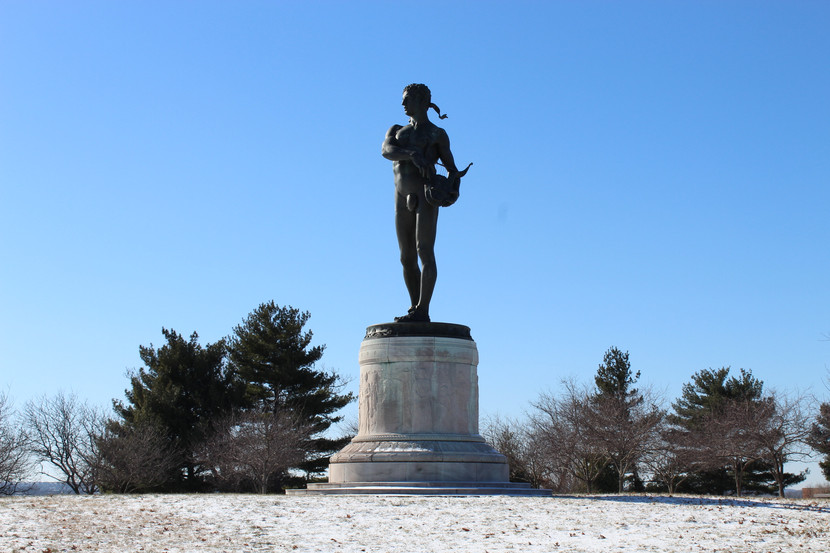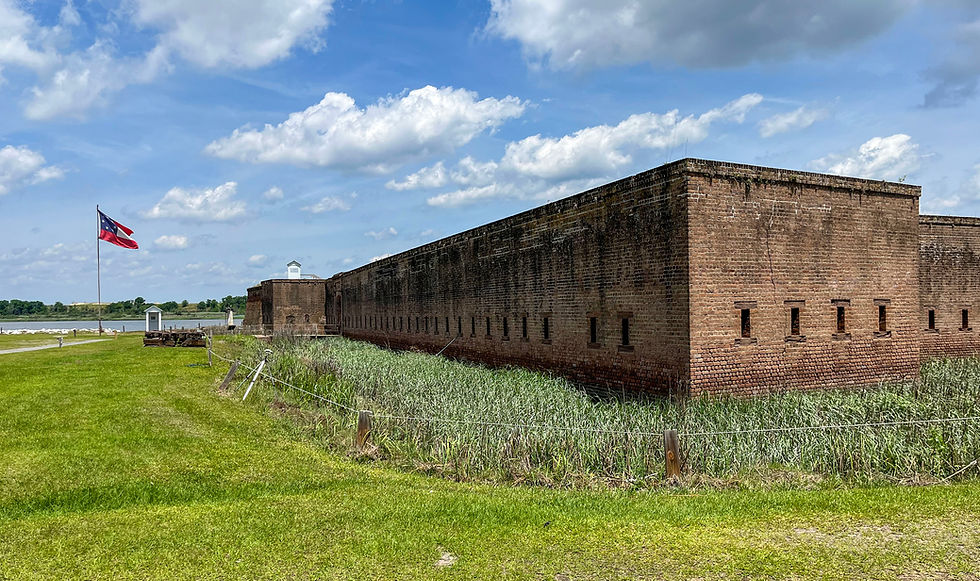Fort McHenry
- Tim Murphy

- Jan 20, 2018
- 9 min read
Updated: Apr 24, 2021
By the dawn's early light, I traveled to Baltimore, Maryland, to visit Fort McHenry--Francis Scott Key's inspiration to write "The Star-Spangled Banner." Completed in 1805 and named after Secretary of War James McHenry, the fort was constructed in accordance with an ambitious defense program to build defenses near young America's primary cities. Fort McHenry's prowess would be tested soon after its completion in a British naval bombardment and amphibious assault known as the Battle of Baltimore. The perseverance and tenacity displayed by American defenders on that day would lead to the composition of the most coveted and immortalized words in United States history.

The Battle of Baltimore and the events that followed shortly after were part of a larger conflict known as the War of 1812. Needless to say, Great Britain was particularly salty towards the young United States in the years following the Revolution. This animosity was displayed through it aggressive maritime policies against the US. Between 1803 and 1812, Britain intercepted American merchant ships and forcibly conscripted the crews into British naval service, a practice known as "impressment." Additionally, Britain required all neutral European trade to pass through England first, a delegation in response to the Napoleonic decrees of trade (because, of course, Britain was at war with France, too). France reacted by intercepting any ship flying under a flag of neutrality, fearing that it may aid their enemies. Britain did the same. Between 1807 and 1812, over 900 American merchant ships were seized under this battle for supremacy of the seas.
If not by sea, then by land...Britain controlled Canadian provinces to the north and west of the United States, making it difficult for the country to expand its landholdings. This, coupled with economic struggles from the maritime trade debacles, placed a great strain on the United States. Many people believed that the actions of Britain infringed their national rights, and pretty soon that sentiment reached its tipping-point. On June 18, 1812, President James Madison signed a declaration of war against Britain, thus beginning the War of 1812.
The War of 1812 was fought on many fronts: from the Gulf of Mexico to Canada. In early 1814, the conflict came to the Chesapeake Bay. Following Napoleon's defeat in Europe, Britain was able to turn its full attention towards the war in America. Looking to inflict as much economic destruction as possible, the British targeted Washington D.C. and Baltimore during their campaign. The British fleet strung a nearly-impenetrable naval blockade along the East Coast, preventing both imports and exports to go through. Additionally, the British offered slaves--the main workforce of the cash crop industry--freedom in the form of enlistment or resettlement in their territories. These tactics resulted in an 80-85% drop in American commerce and trade for that year.
Economic strife wasn't the only thing on the minds of the British. Retaliation was, too. In August 1814, British troops landed in Benedict, Maryland, just northeast of Washington D.C. The Americans were taken by surprise, as the Capitol had no fortifications protecting it from attack (a minor flaw considering the circumstances). Hastily, earthworks were dug and the city evacuated. The green American army met the seasoned British at Bladensburg on August 24 in an effort to defend the city from invasion and it couldn't have gone worse. They were immediately routed in what was later described as "the greatest disgrace ever dealt to American arms." With no military defense left, Washington was at the mercy of the British. After sacking and looting the city, all of the public and government buildings were burned, including the White House and Capitol Building.

From Washington, the British marched on to Baltimore, which was the third most populous city at the time. Unlike Washington, Baltimore had multiple earthworks surrounding the city, a 15,000-man army, and Fort McHenry. On September 12, the British landed just east of Baltimore and marched their way toward the city. They encountered a small US militia along the way and a skirmish ensued, called the Battle of North Point. Brigadier General John Stricker and the citizen-soldiers of the Maryland Militia were tasked with delaying the British advance. The violent firefight for an hour and a half. While the British were eventually able to repulse the Americans, they suffered many casualties, including their commander Major General Robert Ross. The fighting and loss of their leader delayed their attack on Baltimore until the following day.
The British plan of attack was to bombard Fort McHenry and the other defense outposts from the Patapsco River. They hoped that this would distract the Americans and allow for a successful, simultaneous land assault. Once the fort had been taken, the British fleet could move further upriver towards the city.
Fort McHenry was the last line of defense between the British fleet and Baltimore. Major George Armistead, commander of the 1,000 militiamen at the fort, recognized the graveness of the situation. If the fort was to fall, Baltimore would follow suit; a crushing blow to the American side and potentially a war-ending defeat. Armistead knew that the utmost resiliency was required in order to have a fighting chance against the stronger British force.
At 6 a.m. on September 13, the British began shelling the fort. For over a 25-hour period, the British launched over 1500 shells and struck the fort over 400 times. Despite the intense bombardment, only four Americans were killed. The initial British attack was largely ineffective. Some ships in their fleet moved closer to shore to try to inflict more damage on the fort, but they were met heavy American return fire. The British ships took a lot of damage and were soon forced to return with the rest of their fleet. The following morning, the British withdrew, and it was then did Francis Scott Key see the American flag fly victoriously over Fort McHenry.
Contrary to popular belief, Key wasn't a prisoner of war during the Battle of Baltimore. Instead, he was trying to negotiate the release American detainees from British ships. Key, accompanied by Colonel John S. Skinner, reached the British fleet on September 7, 1814, and dined with British commanders Vice Admiral Sir Alexander Cochrane, Rear Admiral George Cockburn, and Major General Robert Ross. During their discussions, word of the impending assault on Baltimore was leaked. Since Key and Skinner were exposed to this sensitive information, they were confined to a "vessel of truce" until the battle was over.
Key finished his poem on September 16, 1814, in a hotel in Baltimore. His work, originally called "Defence of Fort M'Henry," was promptly delivered to the press, printed on leaflets, and distributed to the public. His poem was sung to the harmony of "Anacreon in Heaven," an English composition that had the alleged reputation of a drinking song. While libations were certainly consumed in celebration, Key intended for the score to be commemorative and embrace the American triumph on that day. In October of that year, Thomas Carr, a Baltimore-based musician, was the first to formally publish the poem under the name "The Star-Spangled Banner."

The anthem espoused and renewed the American identity. This national fervor was further invigorated with the signing of the Treaty of Ghent on February 16, 1815. After months of negotiations, the United States and Britain reached a formal agreement to end the war, with neither side claiming victory. Although listed as a draw, the treaty validated the United States' status as an independent nation. "The war has given the Americans what so essentially lacked," spoke Louis Serrier, French ambassador to the US in 1815, "a national character founded on a glory common to all." With their identity solidified on the world stage, American nationalism and patriotism surged with "The Star-Spangled Banner" as the centerpiece.
In the years following the War of 1812, the fort went under a number of renovations repairing the ramparts, earthworks, and barracks; however, the military activity around the fort was minimal. In 1846, with a declaration of war against Mexico, Fort McHenry served as a supply depot and training ground for troops being deployed in the Gulf of Mexico.
At the outbreak of the Civil War, Fort McHenry was occupied by Federal troops and housed political prisoners of war. In 1861 alone, over 250 alleged Southern sympathizers were imprisoned here. Over the course of the war, 2,000 prisoners were held at Fort McHenry. One such prisoner was Frank Key Howard, grandson of Francis Scott Key. Howard was arrested for publishing newspaper editorials disagreeing with a military invasion of the South. As consequence for his publication, he was temporarily detained at the fort and his newspaper permanently shut down. In 1863, the Union army began enlisting black troops in Baltimore. Over 4,000 freedmen and slaves answered the call and formed the 4th US Colored Regiment. Fort McHenry would remain in Union hands for the entire duration of the Civil War.
During the First World War, the grounds of Fort McHenry were converted into one of nation's largest military hospitals. From 1917-23, the hospital (known as General Hospital No. 2) staffed 1,000 doctors and nurses and served over 20,000 soldiers. In 1922, President Warren G. Harding visited the servicemen in the hospital and dedicated a statue of Orpheus--the Greek god of music and poetry--outside the fort walls in honor of Francis Scott Key.
In 1931, "The Star-Spangled Banner" was declared to be the official national anthem of the United States. Between 1931-33, the grounds of the fort were restored and historic structures refurbished to their original early-19th century appearance. In 1933, the fort was relinquished by the US military to the National Park Service. However, the fort would see continued military drills through World War II.

So that's a rather in-depth history of the fort and the War of 1812. Now here's my experience at the site. Getting there was the first challenge. If you've ever driven in Baltimore, you're familiar with the abundance of one-way streets and poorly-designed road system. I swear my GPS had me going through a cement mill at one point. However, I was able to find the park in the midst of an industrial district.
My first stop was the Visitor's Center where I got my 7-day pass and walked through the museum they had to display. The museum had a lot of nice artifacts to show (including an original draft of "The Star-Spangled Banner!") and gave good backgrounds on the War of 1812, the Battle of Baltimore, and Francis Scott Key.
Next, I headed up to the fort, which was smaller than what I had pictured...but let's be honest, it's a fort. It's pretty big. In front of the fort is the Ravelin--a wedge-shaped structure designed to split enemy assaults--and a dry moat. Upon entering the fort through the main gate, you can see the original barracks and guardhouses and a reconstructed flagpole in place of the original. The guardhouse immediately to the left housed prisoners of war during the Civil War, including Henry Hall Brogden who was a Confederate officer and convicted spy. He was originally sentenced to death and awaited his execution at Fort McHenry. However, President Lincoln stepped in on his behalf and waived the death penalty. Brogden was later transferred to Fort Monroe and exchanged for a Union officer in June 1864. Tourists can still visit Brogden's tiny cell today.
There are numerous displays in each barrack building. Starting with the first building on the left (and going clockwise), visitors can see reconstructed living quarters, learn about the history of the fort, and watch a reenactment of the Battle of Baltimore. The barrack across the parade grounds houses more archaeological displays. Archaeologists have been able to uncover some pretty amazing things over the years, including the location of a private late-18th century tavern and the original flagpole cross brace from the War of 1812!
The next building over is the Junior Officers' Quarters. This was the social and logistical center of the fort. Each officer has his own servant (not necessarily black nor a slave). The point of the servants was more out of convenience than anything else. It was a way for officers to stand above the regulars and enlisted men and perform more important duties than daily menial tasks (such as making the bed, cleaning quarters, etc.). A fully-furnished officer's living quarter can be seen in this building today. Adjacent to the officer's quarters is the Magazine, which at one time held 30,000 pounds of black powder (about ten tons of TNT).

The final building I toured was the Commanding Officers' Quarters. It was here that Major George Armistead and his staff discussed defensive strategies for the fort and Baltimore. The front room of these quarters contain interactive exhibits where visitors can visualize the progression of the battle. The room adjacent to the officers' quarters is the guardhouse which stored the 30' x 42' flag that flew the morning of September 14, 1814.
After exploring the inside of the fort, I decided to walk around the grounds and the dry moat. Mounted along the walls of the fort are numerous cannon, including a few Rodman cannons which were capable of firing exploding projectiles weighing up to 440 pounds! Outside the fort is a bike path that traces the coast line of the Patapsco River and passes by the statues of Orpheus and Armistead.
Fort McHenry was a wonderful place to visit. I was a bit surprised at how few people there were on park grounds (could've been that it was 25 degrees and the middle of a weekday, but who knows...). And despite its smaller-than-anticipated size, its significance and contribution to America's legacy cannot be understated. Not only did the defense of this fort save Baltimore, it saved the integrity and identity of this nation and was the source of inspiration to our National Anthem. That in itself should be awe-inspiring enough for you to come visit, too!






















